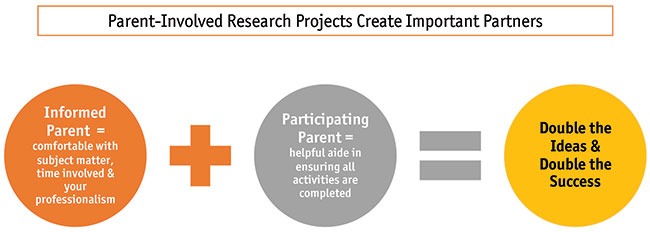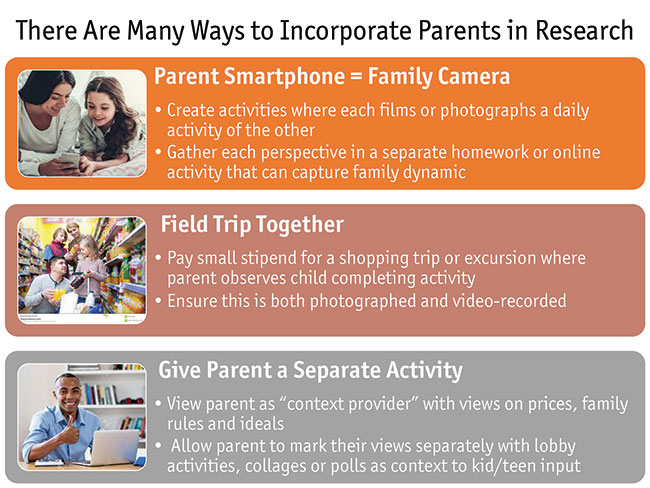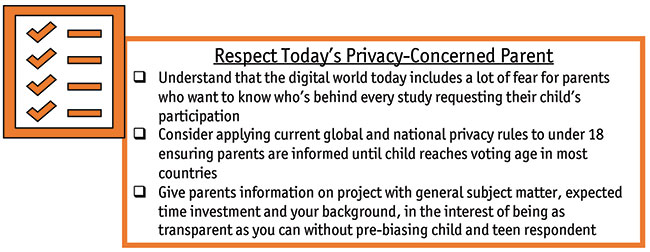Make it a family affair
Editor's note: Pam Goldfarb Liss is founder of Minneapolis research firm LitBrains-Igniting Ideas!
 Ever wonder what to do with parents when working with kids and teens in online qualitative research projects? Parents are already “recruited” as part of every kid/teen project – why not use their input to support your kid/teen learning, too?
Ever wonder what to do with parents when working with kids and teens in online qualitative research projects? Parents are already “recruited” as part of every kid/teen project – why not use their input to support your kid/teen learning, too?
For many years now, I have used an important two-part recruiting process that encourages interviewing parents first, then children. This ensures that children under 18 are articulate, savvy consumers of your client’s product or service. It also is an opportunity to bring parents into the process beyond just getting their permission for their kids to participate. Most often I make parents a part of both my in-person and online work to create a feeling of transparency and cooperation. The result of this collaboration produces a feeling of safety in our data-weary world to encourage a more productive kid and teen respondent – especially more recently with Generation Z. 
Some of the factors that contribute to why parents make a great team with their kids in research projects both online and in-person include:
- A Bloomberg article from August 2019 explains that kids and teens ages 10-25 say that, of the top three people they admire most, parents are up there with God and major celebrities.
- The once-helicopter parent of the Millennial generation is now considered a guide and a friend to this Generation Z child or teen.
- According to a 2018 Pew Research study on Generation Z, children are given autonomy and encouraged to contribute their opinions in major family decisions, thus making consumer research with a parent-child/teen pair a productive and dynamic peek into real-life purchase processes.
- Kids and teens are actually changing the world on issues where parents have been stymied, including a recent global school walkout for climate change and gun control issues here in the U.S. Now more than ever before, kids and teens are empowered to make a difference with their opinions. This is a perfect world for great kid-parent dynamics in research, as both are savvy consumers and citizens.
- There’s a lot of opportunity for researchers to learn and observe how Generation Z spends their time – online especially. Since current data-protection laws require younger respondents to have parental permission to participate, it is necessary to involve parents – and these laws are only evolving into stricter age limits from under-13 to under-18 years in the U.S. and globally.
As research partners, parents help ensure that kids participate fully, because when parents feel that a study is fun their kids will, too. Here are a few of the ways I involve parents in both my in-person and online research methodologies:
- As a matter of safety and practice, I first recruit children and teens under 18 through their parents and then I talk with every child or teen before inviting them to participate in my research projects.
- I provide an introductory/welcome letter addressed to the parents that includes a broad subject overview, an outline of time involved in completing the research and my photo and professional background to ensure that parents are comfortable with their child’s involvement in my research project.
- Children under 18 are required to be driven by a parent to my research projects to ensure parental permission. I get great show rates for in-person work with kids and teens because I insist on parents being present as much as possible for my research.
- Knowing parents will be present at my in-person methodologies, I incorporate parents through exercises about product usage and ideals to be completed in the facility lobby.
- When doing in-home interviews, I ask parents to join us after our discussions with children and teens to hear from their child about what we covered and ask their opinion about some purchase behavior so I have a full context of what happens in their home. I also allow attending clients to ask productive questions of parents about their purchase decision process if they’d like.
- In online research – even with webcam or chat groups requiring only children or teens – I ensure there is a question for mom or dad to contribute before or after the conversation with an eye on providing context to purchase behavior or ideals in the home.

Better participation rate
When I involve mom and dad in research with kids and teens, it’s an almost guaranteed better participation rate for the following reasons:
- Mom and dad model good participant behavior for kids and teens through timely attendance when contributing to in-person work or by logging in and helping their child stay on top of the activities remaining. It’s like they are working for you to help the kids stay on track much as they do with their child’s schoolwork.
- Parents are excited about the fact that their child’s opinions are important to companies because they are definitely important opinions to how their households operate. It’s a genuine dynamic where opinions matter and this generation is empowered by its opinions, as evidenced by so much of what we see in the news every day and their role models that include teen bloggers and social activists.
- Many parents in my studies are surprised or enlightened by their child’s answers, which spurs family discussion and more ways to connect – so much so that I often get requests to participate in future studies.
Teacher becomes the student
A fun new dynamic in our research occurs between many parents and their children where the teacher becomes the student. This is often due to the digital divide, where parents are behind children in knowing current shopping tools and the media content that informs a great deal of purchasing behaviors and education. Kids and teens have become passionate advocates for issues of great future impact and inspire their parents as well. They are often more savvy shoppers or researchers on issues and need states, using online and mobile tools that their parents often forget about or don’t use as effectively. Although online and mobile methodologies offer a comfortable place for parent and child to share more surprising or intimate things about themselves, I also see the dynamic of parents becoming the student often with in-person work because of the digital divide. Although kids and teens are still more comfortable telling intimate things about their lives to me separate from their parents, most see themselves as savvy guides to a new digital world that affects so much of family decisions. Kids and teens see themselves as smart guides who know how to find important information to help their parents make smarter decisions. The way that I work with Generation Z kids and teens is similar to but different from the way that I did with Millennials, who did not have that comfort with their parents.

Powerful partnership
Parents are going to be a part of your studies with children under 18 even if they aren’t in your study. In the U.S., a new bipartisan-endorsed addition to Children’s Online Privacy Protection Act (COPPA) is soon to be passed as I write this article in 2019 and it will even allow parents an “eraser button” that would let them remove all of their child’s data from services, so that, without parental permission, your study could collect data that would be required to be removed if not properly vetted by these rules. This new COPPA law is also looking to move the age limit from 13 to 18 to ensure better data protection. GDPR has similar but more proactive requirements for collecting data from children. Across my more than 25 years of experience working with kids and teens, I have required parental permission for under 18 years old for all research projects. Partnering with parents doesn’t have to be just abiding by these rules – it can also create a powerful partnership.
Small stipend
As a general rule of thumb, I do pay my parent partner a small stipend to participate with their child. This ensures an incentivized partner who will be more productive in bringing their child to my research location or assisting to get their child to participate fully online, as much as their small participation provides transparency to them on what I am asking of their child. It is usually a nominal amount of $25 to $50 compared to a child’s larger stipend.
Partnering with a parent in kid and teen research is something I’ve long found productive and I encourage my quantitative research partners to do so as well as it ensures a calmer parent and a more willing child or teen participant. And today, especially with Generation Z, it’s an essential formula for success.
